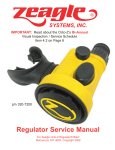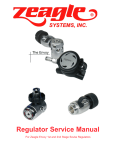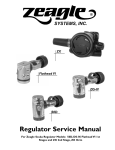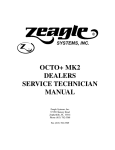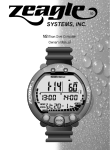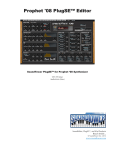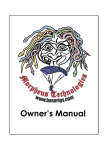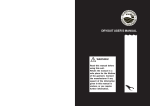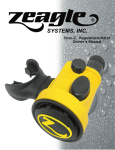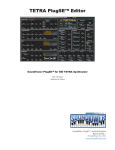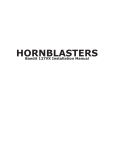Download Flathead-VI Owners Manual Linear layout.indd
Transcript
Flathead VI Owner’s Manual This owner’s manual uses signal words recommended by the American National Standards Institute (see ANSI Z535.4) to designate levels of hazard seriousness. These signal words and their designations are as follows: DANGER: Indicates an imminently hazardous situation which, if not avoided, will result in death or serious injury. This signal word is to be limited to the most extreme situations. WARNING: Indicates a potentially hazardous situation which, if not avoided, could result in death or serious injury. CAUTION: Indicates a potentially hazardous situation which, if not avoided, may result in minor or moderate injury. It may also be used to alert against unsafe practices. Note to European Customers: The Zeagle Flathead-VI regulator is rated for operating temperatures above 10° C. EN250:2000 Certification extends to 50 m. Breathing air used in Zeagle Scuba regulators should meet European EN12021 standards. Table of Contents: Pages Introduction – Safety Information 2 Lifetime Warranty 3 Disclaimer and Limitation of Remedy 4 Cold Water Diving 6 Nitrox Use / First Stages 7 Dry Environmental Sealing / Second Stage Features 8 Resistance Control Knob / Dive/Pre-Dive Venturi Lever 9 10 Octopus Use / Pre-Dive Check 11 Post-Dive Care 12 Maintenance 13 Code Of The Responsible Diver 14 Specifications 15 Service Record 1 Congratulations on your Zeagle Regulator purchase! Your new Zeagle Flathead VI Regulator has been designed and manufactured to the highest possible standards of performance and reliability. With the reasonable care outlined in this manual it will provide you with many years of diving enjoyment. Along with all the high-end features of other Zeagle regulator models, the Flathead VI has unique high-efficiency porting that delivers air to the second stage with less pressure drop and tremendous capacity. Since 1979, Zeagle Systems Inc. has been providing divers with Scuba equipment and Buoyancy Control Devices. Zeagle Systems and our worldwide network of authorized dealers are always ready to serve you. For more information on our products, and for the dealer nearest you, visit our web site at www.zeagle.com. Thank you for choosing Zeagle! Safety Information Read these instructions carefully before using your regulator, and keep this manual for future reference. Following the care and maintenance section at the end of this booklet will help ensure reliable service. 2 Limited Lifetime Warranty To The Original Owner 1. Your regulator is guaranteed against defects in materials and workmanship. This warranty does not cover normal wear, or damage from accident, abuse, neglect, alterations, improper usage, or failure to follow reasonable care and maintenance as outlined in this manual. Under this limited warranty, Zeagle will either repair or replace, at its sole option, any original equipment or parts that fail to perform as intended. Shipping and Labor charges are not included and must be paid by you. To validate your warranty, you must fill out and return your warranty registration card to Zeagle within 30 days of purchase. This Limited Lifetime Warranty excludes filters, hoses, O-rings, diaphragms and mouthpieces, which are warranted for two years from the regulator’s date of purchase. Filling out the card requires printing CLEARLY the serial numbers of both the first and second stages. You can also register your regulator at www.zeagle. com on the internet in the “Product Support” section. The first stage serial number is stamped on the top flat portion of the regulator. (fig. 1). The second stage serial number is stamped on the mouthpiece tube (fig. 2). To read this serial number you must fold back the flexible silicone mouthpiece to expose the numbers. Serial # Each serial number consists of a prefix Fig. 1 letter followed by six numbers. All of the digits of both the first and second stages must be CLEARLY printed on your warranty registration card for your warranty to be activated. Fig. 2. 2. For proof of original ownership, you must save the original purchase receipt. It is your record of when and where the regulator was purchased. It also lets you know when your annual service should be performed. 3. To keep the original-owner Limited Lifetime Warranty in effect, you must have your regulator inspected and serviced annually, within 30 days before or after the anniversary of the purchase date. Failure to do so will invalidate your warranty. This servicing must be performed by an authorized Zeagle dealer. Save the receipts from this servicing for your records. 3 4. This limited warranty applies only to the original purchaser, and then only to certified divers. 5. Sometimes products from other manufacturers are attached to Zeagle equipment. This warranty does not cover those other products or make any claims as to the performance or suitability of those other products. 6. This limited warranty applies only to regulators sold through authorized Zeagle Systems dealers. 7. This warranty gives you specific legal rights. You may also have other rights that may vary from state to state. Disclaimer And Limitation On Remedy (Some States do not allow limitations on how long an implied warranty lasts or do not allow exclusion of incidental or consequential damages, so the following limitations or exclusions may not apply to you.) Zeagle expressly limits any and all warranties, expressed or implied, to the terms of the limited warranty as set forth above Your remedies are limited to those contained herein and are in lieu of all other remedies, whether based on breach of warranty or contract, negligence, strict product liability or other tort. Zeagle specifically disclaims liability for any consequential, special or indirect damages arising out of the use of Zeagle Equipment. 4 CAUTION Scuba products are subject to conditions of extreme wear and corrosion. Inspection and maintenance are required to ensure continued performance. Zeagle recommends that you have your regulator inspected and serviced once a year on the anniversary date of its purchase at any authorized Zeagle Scuba dealer worldwide. Zeagle Scuba equipment should be used by certified scuba divers only. WARNING 1. Scuba diving is an adventuresome activity that involves a degree of risk. Zeagle Systems, Inc. Self Contained Underwater Breathing Apparatus (SCUBA) equipment is only to be used by those trained and certified by a nationally recognized Scuba training agency. Diving without the necessary training in safe diving procedures, or without observing the practices outlined by your training agency for your level of certification, is extremely hazardous and could result in serious personal injury or death. This owner’s manual is in no way meant to be a substitute for the instruction received from a certified Scuba training agency. 2. Zeagle regulators must be serviced only by dealers or technicians trained and authorized to service Zeagle equipment. At no time should any unauthorized person attempt to repair the regulator or adjust any nuts, bolts or screws other than those used to mount the regulator to, or dismount it from the tank valve. Scuba equipment that is not properly serviced might malfunction during use, putting the diver at risk of serious personal injury or death. 5 CAUTION 1. The high-pressure outlets (HP Ports) are distinctly larger than the low-pressure outlets. Only devices with fittings, hoses, and components designed for the full tank pressure that the regulator will be mounted on, such as Submersible Pressure Gauges, are to be installed in these ports. 2. During installation, the O-ring hose fittings will seal with hand-tight pressure, but may come loose during use if not tightened carefully with a small wrench. Proper torque for the hose fittings is 40-45 in lbs. (4.5 - 5 joules) Excessive tightening will not help the seal and may damage the parts (see DEMA Guidelines No. 101, Low Pressure Hose Installation Caution Statement; ANSI American National Standard for Underwater Safety, paragraph 9.3.1). COLD WATER DIVING Cold water is defined as water at a temperature of 50 degrees F (10° C) or lower. However, in cold water there is a risk of the first or second stage freezing. The risk of freezing is increased as the ambient temperature gets lower, the air flow increases, and/or the moisture content of the air supply increases. Regulators for cold water use should have environmentally sealed first stages to prevent water entry and lower the chance of freezing. It is not possible to completely eliminate regulator freezing under all conditions. In order to reduce the possibility you should: 1. Avoid pushing the purge button in the second stage during cold water diving operations. 2. Enter the water and submerge without delay. 3. Avoid high rates of breathing, and excessive inflation of buoyancy devices or dry suits. The deeper the dive the greater the risk. 4. Do not practice buddy breathing, etc. while in cold water. 5. Do not use your regulator to fill lift bags, etc. 6 6. Keep YOUR regulator in YOUR mouth. In an emergency, offer or take the spare regulator. When taking the spare regulator, do not hit the purge button to clear the water (if possible). Clear the regulator with as long a first exhalation as is safely possible. WARNING Extreme cold water diving such as diving under ice requires specialized training and procedures. Do not attempt these activities unless you are fully qualified and properly equipped to do so safely. NITROX USE Zeagle regulators are manufactured using materials suitable for use with oxygen enriched gases (i.e., Nitrox, etc.) providing the oxygen content does not exceed 40%. DANGER Using nitrox (i.e., gas mixtures containing oxygen in excess of 21%) requires special training and proceedures. Improper use of nitrox can lead to personal injury, convulsions, drowning, and death. DANGER Use of gas mixtures containing oxygen in excess of 40% with this regulator, can lead to fires and explosions, causing severe personal injury and death. FIRST STAGES The first stage reduces the high pressure air contained in the cylinder to a constant intermediate pressure of approximately 135 p.s.i. (9.2 BAR). Zeagle first stages are designed to do this with outstanding reliability. 7 Fig. 3 Fig. 4 Fig. 5 The First Stage may be attached to your Scuba cylinder by means of the standard yoke assembly for cylinders using a “post” type valve (fig. 3) or the optional DIN 477 connector for cylinders utilizing a DIN valve (fig. 4). Zeagle offers a DIN to Yoke Converter p/n 330-0001 (fig. 5) that allows DIN fitted regulators to be converted for use with a “post” type valve in a few seconds without using tools. Always mount the regulator on the valve with the clear diaphragm (and black diaphragm trim ring) downwards as shown in Fig. 3, 4, 5. DRY ENVIRONMENTAL SEALING The Zeagle Flathead-VI dry first stage environmental sealing system does not require packing with messy silicone oil, or grease. This systems helps keep the main spring / ambient pressure sensing chamber clean and dry, and works extremely well in cold water conditions. SECOND STAGE FEATURES The Zeagle ZX second stage, is pneumatically balanced and is among the most advanced diver adjustable breathing systems available. No fixed or “automatic” system can achieve an ideal level of breathing performance under all conditions. Zeagle ZX second stages are equipped with separate diver controls for both cracking resistance and venturi boost, to allow the diver to adjust the complete range of breathing characteristics. By using a combination of the two controls, it is possible to tune the regulator to give virtually ideal performance. 8 RESISTANCE CONTROL KNOB This knob adjusts the spring load on the second stage valve and so varies the initial inhalation effort. To adjust the Resistance Control Knob to the easiest breathing setting, turn the knob fully counter-clockwise (fig. 6). Sometimes a slight hissing flow of air may be heard at this setting. If this occurs, turn the knob clockwise (fig. 7) just enough to stop the hissing. Fig. 6 Fig. 7 Counter Clockwise Clockwise DIVE / PRE-DIVE VENTURI LEVER This lever controls the sensitivity of the regulator. The Plus and Minus Positions for the lever are marked on the case beside the lever. To avoid unexpected venturi free flows at the surface, or when jumping into the water, the lever should be set in the PRE-DIVE “-” (forward) position. As soon as the diver is ready to descend, the lever should be moved to the DIVE “+” (back) position. Pre-Dive “-” Position + and Markings Dive “+” Position NOTE: Ask your authorized Zeagle Scuba dealer for in-store instructions and training on the use of the second stage Resistance Control Knob and lever. Your dealer will show you how to make adjustments to get the desired breathing results. To actually experience the effects of the adjustment range, the instruction should be conducted with the diver breathing through a regulator attached to a full air supply. The feel of the regulator breathing underwater is of course somewhat different from the feeling of breathing above the surface. 9 OCTOPUS (Alternate Second Stage) USE The diver controls available on Zeagle second stages make them an excellent choice for Octopus use. An Octopus Regulator is often subjected to conditions that may cause a free-flow. To minimize this turn the Resistance Control Knob most of the way in (Clockwise) and move the Dive / Pre-Dive Lever forward to the “-” Minus position. When the Octopus Regulator is needed for delivering air to a diver, the Resistance Control Knob is turned Counter Clockwise to the easiest breathing position, and the Dive / PreDive Lever is moved back to the DIVE “+” position. Although breathing resistance will be somewhat greater, the regulator will still deliver ample air on demand if the controls are accidentally left in the Pre-Dive position. Longer hoses are available from Zeagle for Octopus use. PRE-DIVE CHECK 1. Before mounting any Scuba regulator onto a tank valve, you must open the valve briefly to blow out any water trapped in the outlet area of the valve. Failing to perform this simple step will often result in water and contaminants being blown into the interior of the regulator, which in turn will cause future mechanical problems in the regulator. 2. Prior to each dive always check to make certain your regulator has no potential water leaks by inhaling lightly on the regulator with the dust cap properly installed, or the tank air valve turned off. You should be able to draw in very little if any air. If you can draw in any quantity of air, either the exhaust valve is failing to seal properly, or there may be a pinhole leak in the mouthpiece or second stage diaphragm. 3. Mount the 1st stage regulator on the tank valve with the clear diaphragm end (with the black logo showing underneath) facing down. 10 4. Just before turning on the tank air valve, check to make sure that the yoke nut or DIN connection is tight and that the regulator body is aligned properly, with no kinks in the hoses. In the case of DIN connections, check that the DIN connector O-ring on the regulator is in place before installing the regulator into the valve. Always carry spare DIN connection O-rings (Zeagle p/n 160-0111-N7). 5. Turn the tank valve on VERY slowly. Check for air leaks and proper breathing function of the regulator. CAUTION If you hear any leaks, turn the tank valve off. Do not use the regulator until the source of the leak has been found and corrected by an authorized Zeagle Scuba service technician. Always mount the regulator on the valve with the clear diaphragm end (with the black logo showing underneath) pointed downwards. WARNING Lifting the tank by the regulator or hoses may loosen a previously tight connection, which could cause unexpected air loss and put the diver at risk during a subsequent dive. You could be physically injured by high pressure air or parts that are propelled by high-pressure air. POST-DIVE CARE 1. After the dive, dry the dust cap and place it securely on the regulator inlet. On multiple tank dives, keep water out of the regulator inlet when changing the tanks. Neglect of these simple procedures is a major cause of corrosion and wear in scuba regulators. Zeagle’s Dry Environmental Sealing System keeps all other water-borne biological contamination out of the first stage body. 2. With the dust cap securely in place, rinse the first and second stage in clean fresh water. DO NOT purge the regulator before or during rinsing 11 since this may introduce water into the second stage and the low-pressure hose. After rinsing, reconnect the regulator to an air supply and thoroughly shake or blow all excess water from the second stage and allow the entire regulator to air dry before storing. For reasons of hygiene, equipment subjected to frequent use in training, rental, etc. should be rinsed in water containing a suitable soap based sterilizing agent. NOTE: DO NOT USE SOLVENT CHEMICALS TO CLEAN THE REGULATOR 3. Store the clean, dry regulator in a clean bag or storage box, away from sunlight, excessive heat and humidity. 4. The Valve Seal in the second stage will give longer service if the Resistance Control Knob on the second stage is turned fully counter clockwise when the regulator is stored longer than a week. MAINTENANCE It is essential that your regulator is checked at least annually by an authorized Zeagle regulator technician. Unusually heavy use, or use in dirty or contaminated water may result in the need for more frequent service. A service record has been provided at the end of this manual to assist you in keeping your regulator’s service up to date. Ask your Zeagle dealer for information on the following products to use with your Zeagle Regulator, adding to your diving enjoyment and safety. • Zeagle BCD’s • Zeagle Instruments • Zeagle Alternate Air Sources • Zeagle Drysuits • Zeagle Router Block 12 The Code of the Responsible Diver • As a responsible diver I understand the risks I may encounter while diving. I will seek experience and knowledge from those with more and will share mine with those who have less. • “Superior divers use their superior knowledge to stay out of situations that would require their superior skills.” • “Your equipment can be excellent, but it is not responsible for you.” • “Your training can be excellent, but it is not responsible for you.” • “Your buddy can be excellent, but he is not responsible for you.” • “You are responsible for you: Be excellent!” 13 SPECIFICATIONS A. FIRST STAGE REGULATOR MODEL: Flathead VI FEATURES: High Efficiency Porting, Balanced Diaphragm, Dry Environmental Seal with Hydro Transmitter. Yoke or DIN inlet available. WEIGHT 2.18 lb. (.99 kg.) INTERMEDIATE PRESSURE 120 -150 psi (8.27-10 bar) # LOW PRESSURE PORTS # HIGH PRESSURE PORTS MATERIALS: Body O-rings Seat HP Valve 4 (3/8”-24 UNF) 2 (7/16”-20 UNF) Brass Buna-N Advanced Polymer Stainless Steel B. SECOND STAGE REGULATOR MODEL: ZX FEATURES: Downstream valve, balanced diaphragm, Diver Adjustable Dive/Pre Dive Venturi Lever and Resistance Control Knob. WEIGHT HOSE LENGTH .26 lb. (.54 kg) ( w/o hose ) 30 in. (.76 m) MATERIALS: Cover Case Poppet Seat O-Rings Diaphragm Exhaust Valve Mouthpiece 14 Flexible Thermoplastic Thermoplastic Elastomer Buna-N Elastomeric Polymer Elastomer Silicone Service Record Date: Service: Date Purchased: 15 Notes: The date of purchase, dive store, and contact information at the store should be written on this page. A copy of the receipt could also be stapled to this page for future records. 16 Zeagle Systems Inc. 37150 Chancey Road, Zephyrhills, FL, 33541 Phone: (813) 782-5568 Fax: (813) 782-5569 www.zeagle.com European Certification Information EC Type examination (Article 10) by: SGS United Kingdom Ltd., Weston-super-Mare, BS22 6WA, UK. Notified Body Number 0120 Meets EN250:2000 Standards p/n 175-1640 © 2004 Zeagle Systems, Inc. Revision A 04/04




















